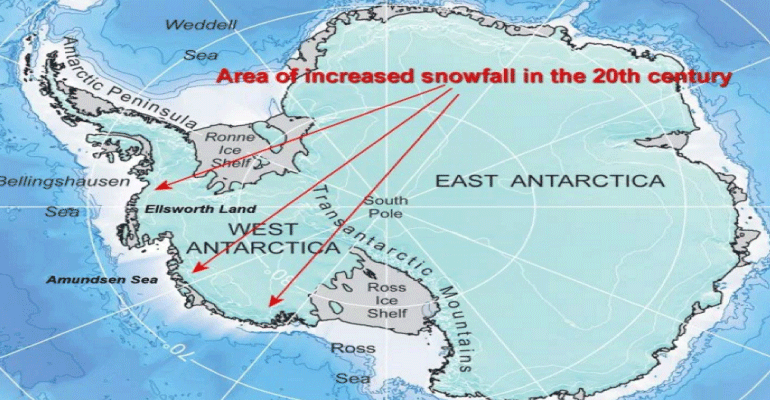
Contrary to the hype that certain coastal glaciers in Antarctica are melting due to global warming, two new studies, one by NASA and one by the American Geophysical Union and the British Antarctic Survey show that gains in snow and ice are more than the losses. With coastal glaciers, if more snow is piles on the top (land side), gravity will make them flow faster to the terminus (into the sea).
NASA:
“A new NASA study says that an increase in Antarctic snow accumulation that began 10,000 years ago is currently adding enough ice to the continent to outweigh the increased losses from its thinning glaciers. According to the new analysis of satellite data, the Antarctic ice sheet showed a net gain of 112 billion tons of ice a year from 1992 to 2001. That net gain slowed to 82 billion tons of ice per year between 2003 and 2008.”
The NASA study is based on radar altimeter data from two European Space Agency European Remote Sensing (ERS) satellites and from NASA’s own satellites. They also used data from ice cores.
NASA says: “The extra snowfall that began 10,000 years ago has been slowly accumulating on the ice sheet and compacting into solid ice over millennia, thickening the ice in East Antarctica and the interior of West Antarctica by an average of 0.7 inches (1.7 centimeters) per year. This small thickening, sustained over thousands of years and spread over the vast expanse of these sectors of Antarctica, corresponds to a very large gain of ice – enough to outweigh the losses from fast-flowing glaciers in other parts of the continent and reduce global sea level rise.” NASA says that the extra accumulating snow is reducing sea level rise by 0.23 millimeters per year (not much, but it shows that local melting in Antarctica is being offset).
AGU & BAS:
The American Geophysical Union/British Antarctic Survey study deals with the West Antarctica peninsula that is subject to warming winds and is underlain by many active volcanoes which add geothermal heat to the area.
“The new study used ice cores to estimate annual snow accumulation from 1712 to 2010 along the coastal West Antarctic. Until 1899, annual snow accumulation remained steady, averaging 33 and 40 centimeters (13 and 16 inches) water, or melted snow, each year at two locations. Annual snow accumulation increased in the early 20th century, rising 30 percent between 1900 and 2010 and the researchers found that in the last 30 years of the study, the ice sheet gained nearly 5 meters (16 feet) more water than it did during the first 30 years of the studied time period.”
The study “attributes the higher annual snow accumulation over the last 30 years in part to an intensification of a regional low pressure system and more storms in the region. These storms could increase as a result of climate change, possibly leading to further increases in snow accumulation.”
These studies are very inconvenient for the big U.N. climate conference in Paris next month where the U.N. will try to extract $100 billion per year from developed countries to mitigate “climate damage” to developing countries. See also:
Paris Conference threatens our Access to Energy
Paris Protocol Amounts to Massive Transfer of the Wealth of Nations
Related articles:
More perspective on Antarctica ice loss
The Bankruptcy of Climate Science
Arizona-Sonora Desert Museum issues position statement on climate change
Note to readers: I have constructed a linked index to more than 300 of my ADI articles. You can see it at: https://wryheat.wordpress.com/adi-index/
You can read my comprehensive, 28-page essay on climate change here: http://wp.me/P3SUNp-1bq
